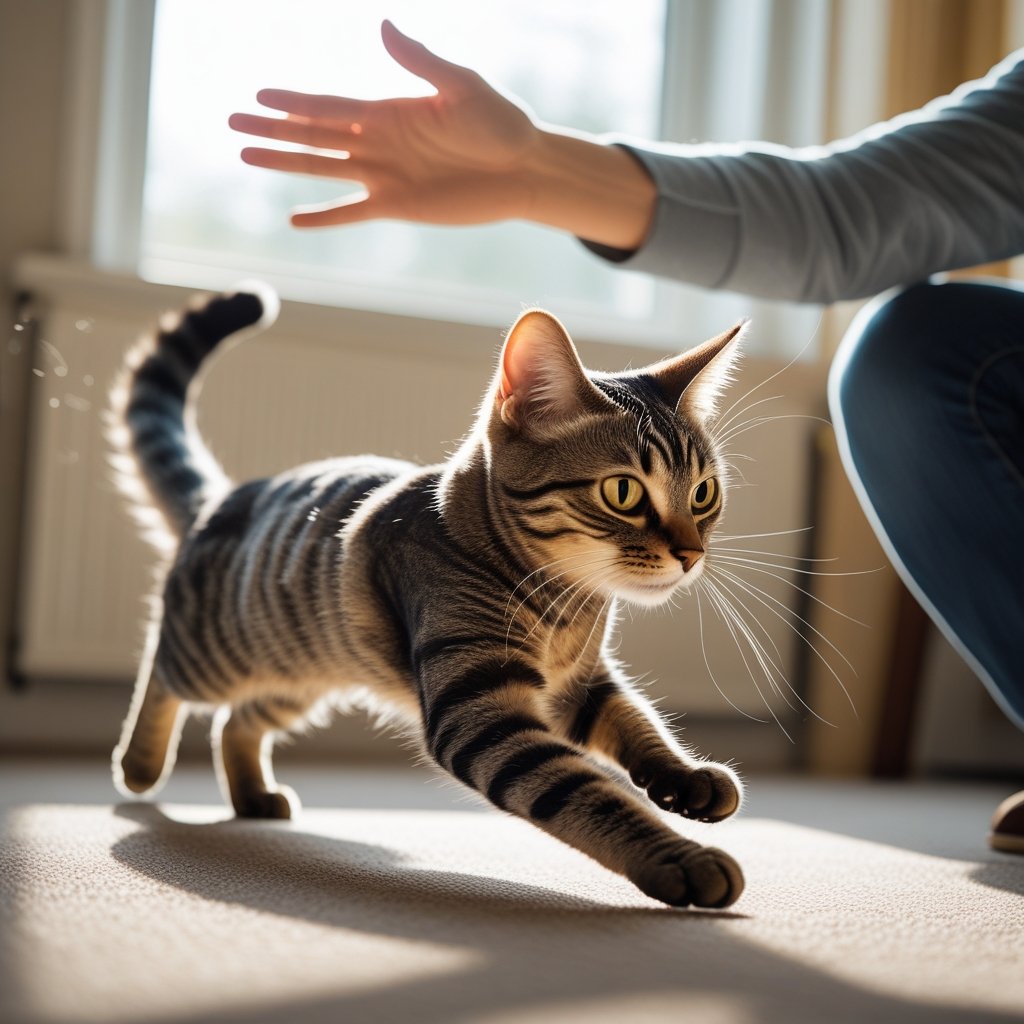Meta Description: Discover why cats display aggressive behavior and how to fix it. Expert guide to understanding cat aggression types, causes, and proven solutions for a peaceful home.
Aggressive behavior in cats is one of the most distressing and potentially dangerous issues cat owners face. Whether your cat suddenly attacks without warning, hisses and swats when approached, or displays territorial aggression toward other pets, these behaviors can strain the human-animal bond and create genuine safety concerns. Understanding that aggression is almost always a symptom of an underlying problem rather than inherent “meanness” is the first step toward effective solutions.
Cats communicate primarily through body language and territorial behaviors that humans often misunderstand or overlook. What appears as unprovoked aggression is usually a cat’s response to fear, pain, overstimulation, or perceived threats in their environment. Unlike dogs, who often give numerous warnings before biting, cats can transition from calm to aggressive seemingly instantaneously, making their behavior appear more volatile and unpredictable than it actually is.
Successfully addressing feline aggression requires identifying the specific type of aggression, understanding its root causes, and implementing targeted interventions that address underlying motivations rather than simply punishing aggressive displays. From fear-based aggression and redirected frustration to play aggression and territorial conflicts, each type requires different management strategies for successful resolution.
This comprehensive guide explores the various types of feline aggression, their underlying causes, warning signs to watch for, and proven solutions that help create peaceful, harmonious households where both cats and humans feel safe and secure.

Types of Feline Aggression: Identifying the Problem
Understanding which type of aggression your cat displays is crucial for implementing effective solutions, as different aggression types require different approaches.
Fear-Based Aggression
Characteristics: Defensive postures including flattened ears, dilated pupils, arched back, piloerection (fluffed fur), and hissing or growling before attacking. Cats typically try to escape before resorting to aggression.
Common Triggers: Unfamiliar people or animals, loud noises, sudden movements, veterinary visits, being cornered with no escape route, or traumatic past experiences.
Why It Happens: Fear aggression is self-defensive behavior when cats perceive threats and believe fighting is their only option to stay safe. This is especially common in under-socialized cats or those with traumatic histories.
Body Language Cues: Crouched position, body pulled away from threat, ears flat against head, tail tucked or thrashing, pupils dilated, attempting to make themselves smaller.
Play Aggression
Characteristics: Stalking, pouncing, biting, and scratching during what appears to be playful interaction. Most common in young cats and kittens with abundant energy and inadequate play outlets.
Common Triggers: Moving feet under blankets, dangling hands, quick movements, or periods of high energy without appropriate play opportunities.
Why It Happens: Cats are predators who need to practice hunting behaviors. Without proper outlets, they direct these instincts toward inappropriate targets like human hands and feet.
Body Language Cues: Dilated pupils, wiggling rear end before pouncing, playful posture without fear indicators, tail swishing excitedly rather than aggressively.
Petting-Induced (Overstimulation) Aggression
Characteristics: Sudden biting or scratching during petting sessions, often after the cat initially seemed to enjoy the interaction. This confusing behavior frustrates many cat owners.
Common Triggers: Prolonged petting, touching sensitive areas (belly, paws, tail base), repetitive stroking in the same spot, or exceeding the cat’s individual tolerance threshold.
Why It Happens: Cats have varying tolerance levels for physical contact. Overstimulation creates discomfort that builds until the cat reacts aggressively to stop the unwanted touch.
Warning Signs: Tail swishing increasing in speed, ears rotating back, skin rippling, dilated pupils, body stiffening, or head turning toward the petting hand.

Redirected Aggression
Characteristics: Sudden, intense aggression directed at an innocent party (person or animal) after the cat becomes aroused by an unrelated stimulus they cannot access.
Common Triggers: Seeing outdoor cats through windows, hearing unfamiliar sounds, being startled, or experiencing frustration from being unable to reach desired targets.
Why It Happens: The cat becomes highly aroused and redirects their aggressive response toward the nearest available target when they cannot attack the actual trigger.
Dangerous Aspect: This is often the most severe type of aggression because the attack can be unprovoked from the victim’s perspective and the cat is in a highly aroused state.
Territorial Aggression
Characteristics: Aggressive behavior toward people or animals entering the cat’s perceived territory, including hissing, blocking doorways, attacking, or marking behaviors.
Common Triggers: New pets, visitors, moving to new homes, changes in household composition, or competition for resources like food, litter boxes, or favorite resting spots.
Why It Happens: Cats are naturally territorial animals who defend their space and resources from perceived intruders or competitors.
Multi-Cat Dynamics: This aggression type is especially common in multi-cat households where territorial boundaries and hierarchies create ongoing conflicts.
Pain-Induced Aggression
Characteristics: Aggression that occurs when touching specific body areas, during handling, or seemingly unprovoked attacks that actually relate to undiagnosed medical conditions.
Common Triggers: Arthritis pain, dental disease, injuries, urinary tract infections, or other medical conditions causing chronic or acute discomfort.
Why It Happens: Cats instinctively hide pain but react aggressively when painful areas are touched or when general discomfort makes them irritable and defensive.
Critical Importance: Always rule out medical causes before treating aggression as purely behavioral, as addressing underlying pain often resolves aggressive behaviors completely.
Common Causes and Contributing Factors
Understanding the broader context and contributing factors helps address root causes rather than just managing symptoms.
Inadequate Socialization
Early Development Impact: The critical socialization period for kittens occurs between 2-7 weeks. Kittens with limited positive exposure to people, other animals, and various experiences during this window may develop fear-based aggression.
Long-Term Effects: Under-socialized cats often display fear aggression toward strangers, fear of handling, and difficulty adjusting to changes in their environment.
Adult Cat Challenges: Cats adopted from feral colonies, outdoor backgrounds, or neglectful situations may never have received proper socialization.
Environmental Stress and Changes
Household Disruptions: Moving, renovations, new family members (human or animal), schedule changes, or furniture rearrangements can trigger stress-related aggression.
Resource Competition: Insufficient litter boxes, feeding stations, water bowls, or resting areas create competition and conflict in multi-cat households.
Lack of Enrichment: Boredom and pent-up energy from inadequate environmental stimulation contribute to both play aggression and general irritability.

Medical Conditions
Pain-Related Issues: Arthritis, dental disease, injuries, infections, and gastrointestinal problems can cause pain that manifests as aggression.
Neurological Problems: Brain tumors, cognitive dysfunction, thyroid disorders, and other neurological conditions may alter behavior and increase aggression.
Hormonal Influences: Intact (unspayed/unneutered) cats display more territorial and sexual aggression than altered cats.
Learning and Reinforcement
Unintentional Reinforcement: Responding to aggressive behavior with attention, treats, or retreat teaches cats that aggression achieves desired outcomes.
Successful Aggression: If aggressive displays successfully eliminate threats or obtain resources, cats learn to repeat these behaviors.
Punishment Backfire: Physical punishment or harsh verbal corrections often increase fear-based aggression while damaging the human-cat relationship.
Reading Warning Signs: Body Language Before Attacks
Learning to recognize pre-aggression body language allows you to intervene before attacks occur and helps prevent escalation.
Escalating Aggression Signals
Early Warning Signs:
- Tail tip twitching or swishing
- Ears rotating backward or to the sides
- Dilated pupils despite adequate lighting
- Focused, intense staring
- Whiskers pulled back or forward aggressively
- Body becoming tense or rigid
Moderate Warning Signs:
- Tail lashing or thrashing
- Ears flattened completely against head
- Low growling or hissing
- Crouched body position or arched back
- Piloerection (fur standing on end)
- Attempting to move away or create distance
Immediate Pre-Attack Signals:
- Direct, unblinking stare
- Body coiled and ready to spring
- Rear end wiggling before pouncing
- Loud yowling or screaming
- Claws extended and visible
- Teeth bared or lips pulled back

Understanding Body Language Context
Defensive Postures: Body pulled away, trying to appear smaller, ears flat, pupils dilated, hissing while backing away – indicates fear-based aggression.
Offensive Postures: Body moving forward, trying to appear larger, ears forward or back, direct approach, confident stance – indicates territorial or predatory aggression.
Overstimulation Signs: Occurring during petting, skin rippling, tail swishing increasing in intensity, head turning toward hand – indicates petting-induced aggression building.
Effective Solutions and Management Strategies
Addressing feline aggression requires patient, consistent approaches tailored to specific aggression types and underlying causes.
Medical Evaluation: The Essential First Step
Veterinary Examination: Always begin with comprehensive veterinary evaluation to rule out pain, illness, or medical conditions contributing to aggressive behavior.
Recommended Testing: Blood work, urinalysis, thyroid testing, and physical examination help identify hidden medical causes.
Pain Management: If pain is identified, appropriate pain relief often dramatically reduces or eliminates aggressive behaviors.
Environmental Modifications
Resource Management: In multi-cat households, provide multiple resources (litter boxes, feeding stations, water bowls, resting areas) following the “N+1” rule (one per cat plus one extra).
Safe Spaces: Create escape routes and elevated resting areas where cats can retreat when feeling threatened or overwhelmed.
Environmental Enrichment: Provide interactive toys, puzzle feeders, cat trees, window perches, and regular play sessions to reduce boredom and excess energy.
Conflict Reduction: In multi-cat homes, temporarily separate aggressive cats, then gradually reintroduce them using positive associations and controlled exposure.
Behavior Modification Techniques
Desensitization: Gradually expose fearful cats to triggers at low intensities while maintaining positive experiences, slowly building tolerance over time.
Counter-Conditioning: Create positive associations with previously feared stimuli by pairing exposure with treats, play, or other rewards.
Redirecting Play Aggression: Teach appropriate play using interactive toys rather than hands and feet. Stop play immediately if biting or scratching occurs.
Respecting Boundaries: Learn individual cats’ petting tolerance levels and stop before reaching their threshold. Watch for warning signals and honor them.
Managing Redirected Aggression
Immediate Response: When redirected aggression occurs, calmly separate the cat from victims without punishment or confrontation.
Cooling Down Period: Allow 24-48 hours for the aroused cat to completely calm down before attempting reintroduction to victims.
Trigger Management: Block visual access to outdoor cats, use window films, or close curtains to prevent arousal from outside stimuli.
Gradual Reintroduction: Reintroduce the aggressive cat to household members gradually, using treats and positive associations to rebuild relationships.
Pheromone Therapy
Synthetic Pheromones: Products like Feliway replicate calming facial pheromones that help reduce stress-related aggression in many cats.
Application Methods: Plug-in diffusers provide continuous pheromone distribution, while sprays can be applied to specific problem areas or carriers.
Multi-Cat Formulations: Special pheromone blends designed for multi-cat households help reduce territorial conflicts and promote harmony.
Professional Intervention

Veterinary Behaviorists: Board-certified specialists in veterinary behavior medicine can diagnose complex cases and prescribe behavior modification protocols or medications when needed.
Certified Cat Behaviorists: Professional cat behavior consultants provide in-home assessments and customized behavior modification plans.
Medication Options: In severe cases, anti-anxiety medications or anti-depressants may be prescribed alongside behavior modification to reduce aggression and facilitate training.
What NOT to Do: Avoiding Common Mistakes
Certain responses to aggression can worsen problems or damage the human-cat relationship.
Counterproductive Responses
Physical Punishment: Never hit, shake, or physically punish aggressive cats. This increases fear, damages trust, and often escalates aggression.
Yelling or Harsh Corrections: Loud verbal punishment increases anxiety and fear without teaching alternative behaviors.
Forced Interaction: Never force fearful or aggressive cats into situations they’re trying to avoid. This confirms their fears and worsens aggression.
Punishment After the Fact: Cats don’t understand delayed consequences. Punishing after aggression occurs creates confusion and anxiety without changing behavior.
Dangerous Practices
Using Spray Bottles: While popular, spray bottle punishment often increases anxiety, creates negative associations with owners, and doesn’t address underlying causes.
Ignoring Warning Signs: Dismissing early aggression warning signs allows behavior to escalate and become more difficult to modify.
Rehoming Without Addressing Causes: Passing aggressive cats to new homes without addressing underlying issues often perpetuates problems in new environments.
Creating Long-Term Harmony

Successful aggression management requires ongoing commitment to maintaining environments and relationships that prevent recurring problems.
Consistency and Patience
Time Requirements: Behavior modification often takes weeks or months. Expect gradual improvement rather than immediate resolution.
Family Cooperation: All household members must implement consistent approaches and respect established boundaries.
Realistic Expectations: Some cats may always have lower tolerance thresholds or specific triggers requiring ongoing management rather than complete elimination.
Ongoing Management
Environmental Maintenance: Continue providing adequate resources, enrichment, and safe spaces even after aggression improves.
Health Monitoring: Regular veterinary checkups catch medical issues early before they trigger pain-related aggression.
Stress Management: Minimize household stressors and provide stability through consistent routines and familiar environments.
Frequently Asked Questions About Cat Aggression
Q: Can aggressive cats ever be completely cured?
A: Many cats show dramatic improvement or complete resolution of aggression with proper intervention. However, some may always require ongoing management, especially if aggression stems from chronic medical conditions or severe early trauma.
Q: Is it safe to keep an aggressive cat around children?
A: This depends on aggression severity and type. Mild play aggression can be managed safely, but severe fear or redirected aggression may pose risks. Always supervise children with cats and teach appropriate interaction methods.
Q: Should I rehome my aggressive cat?
A: Rehoming should be a last resort after exhausting behavior modification efforts with professional guidance. Many aggressive behaviors can be successfully managed or resolved, and rehoming doesn’t guarantee problem resolution.
Q: How do I know if my cat’s aggression requires medication?
A: Consult veterinary behaviorists when aggression is severe, doesn’t respond to behavior modification alone, or significantly impacts quality of life for cats or humans. Medication combined with training often provides the best outcomes.
Q: Can spaying/neutering reduce aggression?
A: Yes, altering cats reduces hormone-driven territorial and sexual aggression significantly. However, it doesn’t eliminate all aggression types, especially those rooted in fear, pain, or learned behaviors.
Conclusion: Understanding Leads to Solutions
Aggressive cat behavior, while challenging and sometimes frightening, is rarely random or malicious. Nearly all feline aggression stems from identifiable causes including fear, pain, overstimulation, redirected frustration, or territorial stress. Understanding these underlying motivations transforms aggressive cats from “bad” or “mean” animals into individuals experiencing problems that humans can help resolve.
The key to successfully addressing aggression lies in patient observation, accurate identification of aggression types and triggers, thorough medical evaluation, and implementation of targeted behavior modification strategies that address root causes. While quick fixes rarely exist for established aggressive behaviors, consistent, compassionate approaches typically yield significant improvements over time.
Remember that punishment and forceful responses almost always worsen aggression while damaging the trust essential for successful behavior modification. Instead, focus on creating safe environments, respecting feline communication signals, providing adequate outlets for natural behaviors, and building positive associations that replace fear and frustration with confidence and security.
Living with an aggressive cat requires dedication, patience, and sometimes professional guidance, but the rewards of transforming a stressed, aggressive cat into a confident, peaceful companion make the effort worthwhile. With proper understanding and intervention, most aggressive cats can become treasured family members who enrich rather than threaten household harmony.
Have you successfully managed cat aggression? Share your experiences and strategies in the comments below!
Dealing with aggressive cat behavior? Check out our recommendations for interactive toys that redirect play aggression, calming pheromone products, and environmental enrichment solutions that reduce stress and promote peaceful feline behavior.
Related Articles You Might Enjoy:
- “Understanding Cat Body Language: What Your Cat Is Really Telling You”
- “How to Litter Train Your Cat (Even Older Ones)”
- “The Importance of Vet Checkups for Cats”
- “15 Funniest Cat Behaviors Explained”
Keywords: aggressive cat behavior, cat aggression causes, stop cat aggression, cat behavior problems, feline aggression, cat attacking, mean cat behavior, cat biting scratching, aggressive cat solutions

